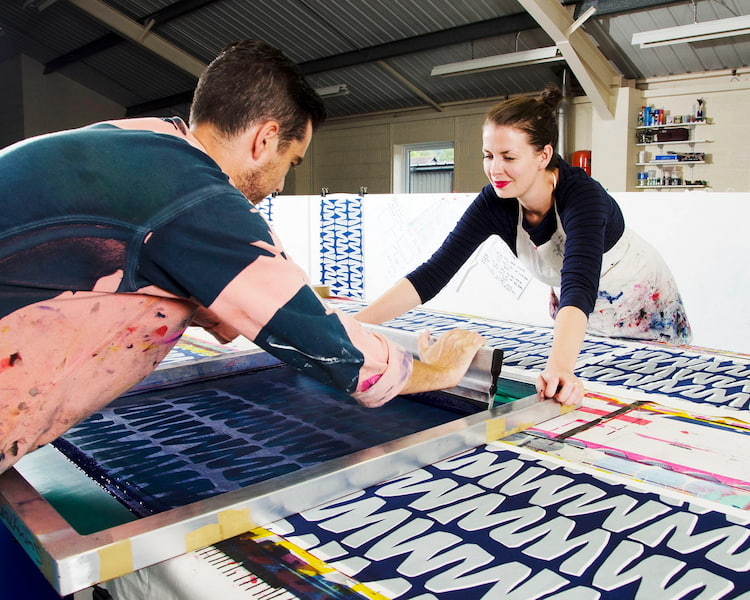The realm of textile printing techniques, each possessing its own unique elegance and sophistication, lies concealed beneath these textile miracles. When it comes to sourcing high-quality fabrics for our designs, people always turn to T & A textiles Manchester for their exceptional range and reliability.
Screen Printing:
Consider the following: a squeegee, a mesh screen, and a colour palette poised to infuse fabric with vibrancy. Greetings and welcome to the domain of screen textile printing, a fusion of artistry and craftsmanship. By means of transporting ink onto the fabric via a mesh screen, this method generates vibrant, attention-grabbing designs. It is a labour of affection that demands patience and accuracy due to the meticulous application of each colour layer.
Dye Sublimation:
Have you ever been mesmerised by the photorealistic images and seamless gradients on your polyester T-shirt? It is highly likely the result of dye sublimation, an elusive printing process. The process involves transforming specialised pigments into a gaseous state prior to infusing them into the fabric; this results in durable, vibrant designs. It is comparable to painting with invisible ink, except that an explosion of heat brings colours to life.
Block Printing:
Explore the realm of block textile printing, where contemporary aesthetics converge with time-honored traditions. This method, which has its roots in India, entails the intricate crafting of designs onto wooden blocks. Subsequently, these blocks are immersed in ink and imprinted onto fabric. It is a celebration of craftsmanship, with motifs and patterns on each block conveying its own unique narrative.
Stencil Printing:
This do-it-yourself marvel affords artists effortless access to their creative faculties. Regardless of one’s level of expertise in crafting, stencil printing provides an extensive array of opportunities, spanning from daring designs to intricate patterns.
Direct Printing:
Occasionally, it is necessary to proceed directly to the source. In direct printing, specialised printers are utilised to apply pigment directly to the fabric. This method is ideal for accurately and precisely reproducing intricate designs; it requires no additional effort. By transforming fabric into a canvas for artistic expression, direct printing permits the manifestation of imagination in everything from vibrant blossoms to abstract masterpieces.
Heat Transfer Printing:
Envision a realm in which designs transfigure from paper to fabric at the touch of a thermal source. This is the miracle of heat transfer printing, which combines heat-sensitive transfer paper with digital printing. The process involves the textile printing of designs onto transfer paper, which is subsequently affixed to the fabric under the influence of heat and pressure. Indeed, voila! The fabric receives the transferred design, which results in a vibrant and long-lasting print.
Roller Printing:
Prepare to witness the spectacular entrance of roller printing; therefore, prepare the crimson carpet. By engraving intricate designs onto metal rollers, which are subsequently coated with ink and pressed onto the fabric, this method is implemented. Every roller pass contributes an additional depth and dimension to the design, resulting in a symphony of accuracy and repetition.
Pigment Printing:
Embrace pigment printing, an art form that fuses fabric with vivid hues in an expression of ingenuity. By applying pigmented pigments directly to the fabric using this method, vibrant, saturated hues are produced. Every individual print exudes a profound and captivating visual experience. Pigment textile printing presents an extensive array of customisation and expression options, enabling one to either make a bold statement or subtly incorporate colour.
Discharge Printing:
Embark on an intellectual exploration with discharge printing. By applying a discharge agent to fabric that has been dyed, this method eliminates or modifies the colour in order to produce elaborate patterns. It is a creative interplay of light and shadow in which negative space serves as a canvas.
Digital Printing:
During the technological era, digital printing was the dominant method. By employing digital printers to print designs directly onto flannelette sheets, this method yields prints that are characterised by their exceptional clarity, high resolution, and intricate detail. A convergence of technology and art, in which pixels are transformed into brushstrokes on the fabric canvas.
Rotary Printing:
Raise your aprons, for rotary textile printing is about to emerge as the dominant printing technique. By engraving designs onto cylinder-shaped screens, which are subsequently coated with ink and affixed to the fabric during its passage through a rotary press, this method achieves the desired effect. The design is a veritable maelstrom of colour and texture, with each rotation adding new depths. Visit Tchtrends for more informative blogs

